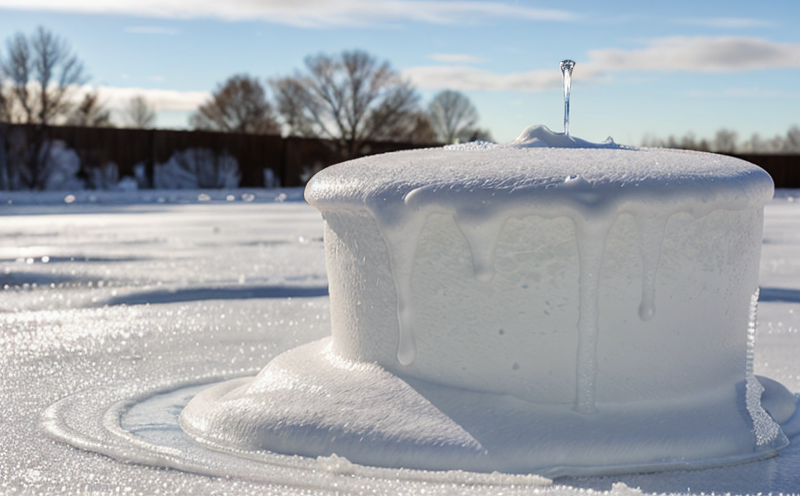FAA AC 20-73 Aircraft Ice Protection Safety Testing
The Federal Aviation Administration (FAA) Advisory Circular AC 20-73 provides guidelines for the development and approval of ice protection systems on aircraft. This service ensures that all safety requirements are met to prevent icing conditions from compromising flight safety, thereby reducing risks associated with in-flight icing events.
The process involves simulating actual icing environments using controlled laboratory setups. These tests are critical because they help manufacturers ensure their designs meet stringent FAA and International Civil Aviation Organization (ICAO) standards. By adhering to these protocols, aircraft can be certified as safe for commercial operations, enhancing passenger safety and regulatory compliance.
The testing covers various aspects of ice protection systems including anti-icing, de-icing, and rain repellency. These tests are essential for verifying the performance under real-world conditions where icing can occur. The primary objective is to determine whether an aircraft’s design can effectively prevent or remove ice accumulation on key surfaces such as wings, propellers, and engine inlets.
Our laboratory uses state-of-the-art equipment and methodologies that mimic actual atmospheric conditions. This ensures the accuracy of our tests and provides reliable data for certification purposes. The service includes a comprehensive report detailing all test parameters, results, and recommendations for improvements if necessary. Our team of experts is dedicated to providing accurate and timely testing services, ensuring your product meets all FAA requirements.
In addition to meeting regulatory standards, this service also helps manufacturers identify potential design flaws early in the development process. By incorporating feedback from rigorous testing, companies can improve their products’ reliability and safety, leading to enhanced market acceptance and competitive advantage.
Applied Standards
The FAA AC 20-73 is primarily based on international standards such as ISO 15985-4:2006 for the development of ice protection systems. Additionally, ASTM E2252 and ICAO Doc 9804 provide supplementary guidance.
These standards cover various aspects including:
- Environmental simulation
- Test specimen preparation
- Instrumentation and measurement techniques
- Data collection and analysis
- Acceptance criteria for system performance
The standards ensure that all testing is conducted under controlled conditions that closely replicate actual flight environments. This approach guarantees consistent results across different test facilities, enhancing the credibility of the certification process.
Scope and Methodology
| Test Parameter | Description | Acceptance Criteria |
|---|---|---|
| Airflow velocity | Simulates the wind speeds encountered during flight. | Range: 30–120 m/s, depending on altitude and speed of aircraft. |
| Icing fluid type | Represents different types of icing conditions found in various regions. | ISO 9863-1:2014 standards are followed for selecting appropriate fluids. |
| Temperature control | Mimics the temperature ranges experienced by aircraft during flights. | -25°C to +10°C, adjusted based on altitude and season. |
| Icing duration | Determines the length of time required for ice formation under specified conditions. | Varies between 30 minutes up to several hours depending on test objectives. |
The testing process begins with careful preparation of the aircraft model or component under test. This involves cleaning and conditioning the surface according to specific protocols outlined in FAA AC 20-73. Once prepared, the sample is placed into a controlled environment where icing conditions are created.
Data collection during these tests includes continuous monitoring of temperature, humidity levels, airflow rates, and ice accumulation rates. Specialized instruments measure the thickness and distribution of ice formed on critical surfaces. After achieving the desired level of icing, de-icing procedures are implemented to assess their effectiveness. The entire process is meticulously documented, ensuring thorough evaluation of both anti-icing and de-icing capabilities.
Acceptance criteria for each test are strictly adhered to based on FAA AC 20-73 requirements. Compliance with these stringent standards ensures that the aircraft or component can withstand expected icing conditions without compromising safety or performance.
Eurolab offers unparalleled expertise in aerospace testing, leveraging decades of experience and cutting-edge technology to deliver accurate and reliable results. Our team of highly qualified engineers and technicians ensures that every test adheres precisely to FAA AC 20-73 guidelines.
We provide a range of additional services tailored specifically for the aerospace industry, including:
- Pre-test consultation
- Post-test analysis and reporting
- Training programs for quality managers and compliance officers
- Customized testing solutions based on specific client needs
Our commitment to excellence extends beyond just meeting regulatory requirements. We strive to exceed expectations by offering innovative approaches that enhance product performance and safety.





